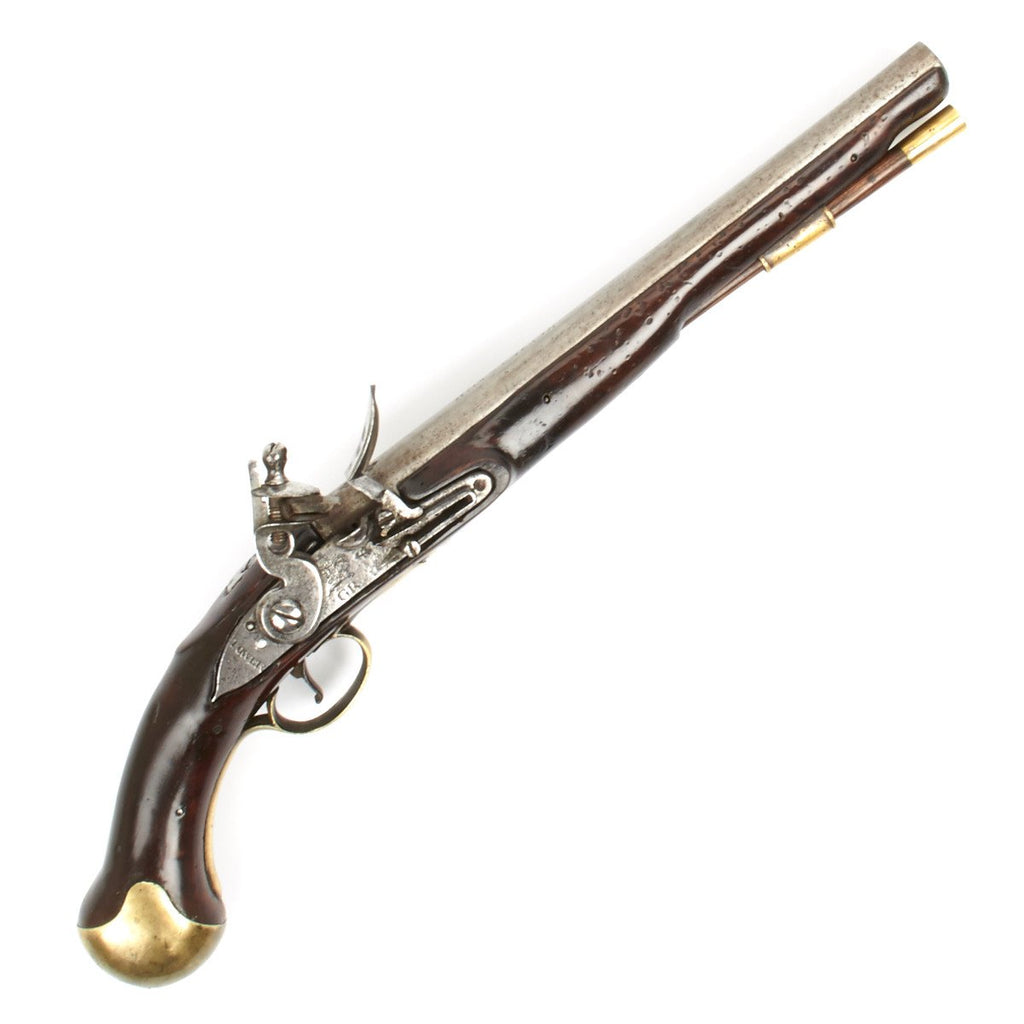-
Original Item: One-of-a-kind. This is a fine standard British Flintlock Sea Service Pistol made with 12" barrel, belt hook and all brass mounts. Interestingly it has no re-enforcement between the pan and the frizzen suggesting that the lock of the pistol may date from as early as the 1770s. The Lock plate is marked with:
(Crown) G.R
Tower
The barrel is faintly engraved:
HMS CAESAR HMS Caesar, also Cæsar, was an 80-gun third-rate ship of the line of the Royal Navy, launched on 16 November 1793 at Plymouth. She was designed by Sir Edward Hunt, and was the only ship built to her draught. She was also one of only two British-built 80-gun ships of the period, the other being HMS Foudroyant (1798).
Battle of Algeciras Bay
She was involved in the Battle of Algeciras Bay in 1801, during which her Master, William Grave, was killed and buried in Trafalgar Cemetery in Gibraltar.
Battle of Cape Ortegal
The Battle of Cape Ortegal was the final action of the Trafalgar Campaign, and was fought between a squadron of the Royal Navy and a remnant of the fleet that had been destroyed several weeks earlier at the Battle of Trafalgar. It took place on 4 November 1805 off Cape Ortegal, in northwest Spain and saw a squadron under Captain Sir Richard Strachan in Caesar defeat and capture a French squadron under Rear-Admiral Pierre Dumanoir le Pelley.
Battle of Les Sables-d'Olonne
In 1809, she took part in the Battle of Les Sables-d'Olonne. The Battle of Les Sables-d'Olonne was a limited frigate action that took place on 23 February 1809 off Les Sables-d'Olonne. Three ships of the line and two attached ships of the British squadron blockading the harbours of the Atlantic coast engaged a small French frigate squadron comprising Calypso (40), Cybèle (40) and Italienne (40). The French managed to repel the British attack but at the cost of irreparable damage leading to the subsequent decommissioning of the three frigates involved.
On 23 February, the French frigate squadron arrived near Belle Île. The frigate HMS Amelia (38) and the 18-gun brig-sloop Dotterel spotted the squadron and shadowed it. A few hours later, Calypso spotted five ships and a frigate heading to Lorient. The chase went on all night. The next morning, as the frigates arrived off Tour de la Baleine on the Île de Ré, the British ships were so close that they started manoeuvering to pass the stern of Cybèle. The French then challenged Amelia and Dotterel, which failed to answer their signals, and Italienne hauled up to support Cybèle. La Gravière then decided to seek refuge at Les Sables-d'Olonne, under the protection of coastal defences, before larger British forces could gather.
The French arrived at Les Sables-d'Olonne at 9:15 and made anchor in shallow waters. A quarter of an hour later, the British arrived, Amelia and Dotterel having joined with the Third Rates HMS Caesar (80), HMS Defiance (74) and HMS Donegal (74), under Admiral Robert Stopford. In spite of the shallow waters, Defiance was able to anchor within half a mile of the French frigates, on the right of Italienne, whilst HMS Donegal and HMS Caesar had to anchor further out because of their deeper draughts.
A furious artillery exchange broke out that caused considerable damage to all involved. Italienne and Cybèle had their cables cut and caught fire, while Calypso was beached. Three hours into the fight, Defiance, whose manoeuvers the high reefs had hampered, found herself stranded in an unfavourable position and exposed to French fire for so long that she had to retreat, her stern entirely destroyed. The frigates and coastal forts inflicted lesser damage on Caesar and Donegal. Amelia had her bowsprit shot through and she was holed in several places but had no casualties.
An hour and a half afterwards, descending tides made the waters too shallow for the British ships and they had to break off. Jurien de la Gravière's badly battered squadron then entered the harbour of Les Sables d'Olonne, having lost 64 men killed and 47 wounded.
- This product is not available for shipping in US state(s): New Jersey
This product is available for international shipping.
- Not eligible for payment with Paypal or Amazon
- IMA considers all of our antique guns as non-firing, inoperable and/or inert. Title 18, U.S. Code, Section 921(a)(16) defines antique firearms as all guns made prior to 1899. This law exempts antique firearms from any form of gun control or special engineering because they are not legally considered firearms. No FFL, C&R or any license is required to posses, transport, sell or trade Antique guns. All rifles and muskets sold by IMA that were manufactured prior to 1899 are considered Antiques by the US BATF (United States Bureau of Alcohol, Tobacco & Firearms). Therefore, all of IMA's Antique guns may be shipped to all US States and most nations around the world.
These antique guns are not sold in live condition. They are sold as collector’s items or as wall hangers. Any attempt at restoring an antique gun to be operational is strongly discouraged and is done so at the risk of the customer. By purchasing an antique gun from IMA you thereby release IMA, its employees and corporate officers from any and all liability associated with use of our Antique guns.
Pre-1899 Manufacture, no licenses required, allowed to ship to almost any deliverable address across the globe.


We Buy Military Antiques
Our team expert buyers travels the world to pay fair prices for entire estate collections to singular items.
START SELLING TODAY






























